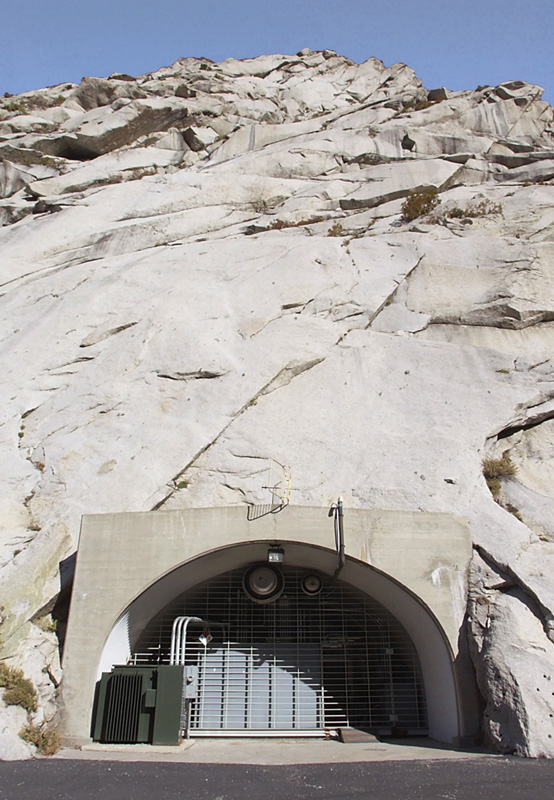
11 Granite Mountain Records Vault
LOCATION Little Cottonwood Canyon, Utah, USA
NEAREST POPULATION HUB Salt Lake City, Utah
SECRECY OVERVIEW High-security location: the record vaults of the Church of Jesus Christ of Latter-day Saints.
The Mormon-run Granite Mountain Records Vault is built deep within a Utah mountainside, and visits by members of the public or journalists are rarely sanctioned. Over the years, this has led some to question why the Church of Jesus Christ of Latter-day Saints is so protective of its privacy at the facility. The Church, meanwhile, argues that its policies are less to do with maintaining secrecy than ensuring security.
Granite Mountain is a deep-storage facility containing a mass of materials related to the Mormon Church, its operations, organizational structure and history. It is also home to a stock of genealogical information perhaps unrivaled anywhere in the world. It is said to include upward of 35 billion items of genealogical data stored on almost 2.5 million rolls of microfilm (a total that increases by around 40,000 rolls per year). The archive employs a staff of 50 to catalog, store, copy and, since 2002, digitize the records.

HALL OF RECORDS A rare photo from deep inside Granite Mountain reveals countless filing cabinets for the safe storage of microfilms capturing genealogical records from around the world in miniaturized form. At the last count, more than 35 billion such images were stored in the vault.
The history of the Mormon Church began in New York in the 1820s, when a man named Joseph Smith claimed to have experienced a series of visions. These included one in which an angel directed him to a hillside, where a book inscribed on gold plates lay buried. In 1830 he published The Book of Mormon, which he said was the translation of these plates, and established a new Church based on their teachings. A little more than a quarter of Smith’s original manuscript remains in existence, but what is left is stored within Granite Mountain.
The movement soon spread, but often found itself in conflict with local populations over its unorthodox beliefs (which in its early days included polygamy). Indeed, Smith himself perished during a skirmish with a mob in Illinois in 1844. Leadership of the Mormons then fell to Brigham Young, who relocated a large group of his followers in 1847 to what is now Salt Lake City—Utah has remained the Church’s spiritual home ever since.
Mormon beliefs emphasize ancestral connections, and as a result, the Church began to accumulate genealogical records from the 1890s onward. From the 1930s, many of these records began to be transferred to microfilm, and within a decade there were more than 100,000 rolls in urgent need of a permanent home. Various sites in Salt Lake City were considered and rejected, until an architect from Little Cottonwood Canyon suggested tunneling into the sheer face of Granite Mountain. Not only would this be an immensely secure location, he argued, but it would provide wonderful temperature regulation—a major concern for all archivists.
Building works commenced in May 1960, with arched tunnels excavated to a depth of 700 meters (2,300 ft), some 250 meters (820 ft) beneath the peak. Three main corridors into the archive, and a further four cross-tunnels, were constructed. The passages were lined with concrete and steel (and painted in tasteful pastel shades, by all accounts), while six storage chambers were also lined with steel—all at a cost of a reputed US$2 million to the Church. The whole complex today covers an area of 6,000 square meters (65,000 sq ft). Huge reinforced entrance doors, weighing between 9 and 14 tons and reputedly able to withstand a nuclear blast, help to protect the facility from uninvited guests.
Storage cabinets 3 meters (10 ft) high accommodate the wealth of archival material. The transfer of microfilm began in 1963, and the vault was fully operational by 1965. Its mountain home offers protection not only from nuclear attack but also from natural disasters such as fire and earthquakes. The Church itself maintains that the records are best protected by strictly limiting their exposure to humans. For this reason, public tours are prohibited, with finger marks, dust and clothing fibers all cited as potential threats to the well-being of the vault’s contents. Since 2001, technological developments have allowed the archive to be kept at a permanent temperature of 13°C (55°F) and at 35 percent humidity.
In 2010, some 300 million of Granite Mountain’s genealogical records were made available online to researchers and members of the public in a major step forward toward openness. Nonetheless, the degree of security maintained at the vault leads many to wonder what other secrets might lie buried deep within its stone.

One of three imposing main entrances to the Granite Mountain Vault